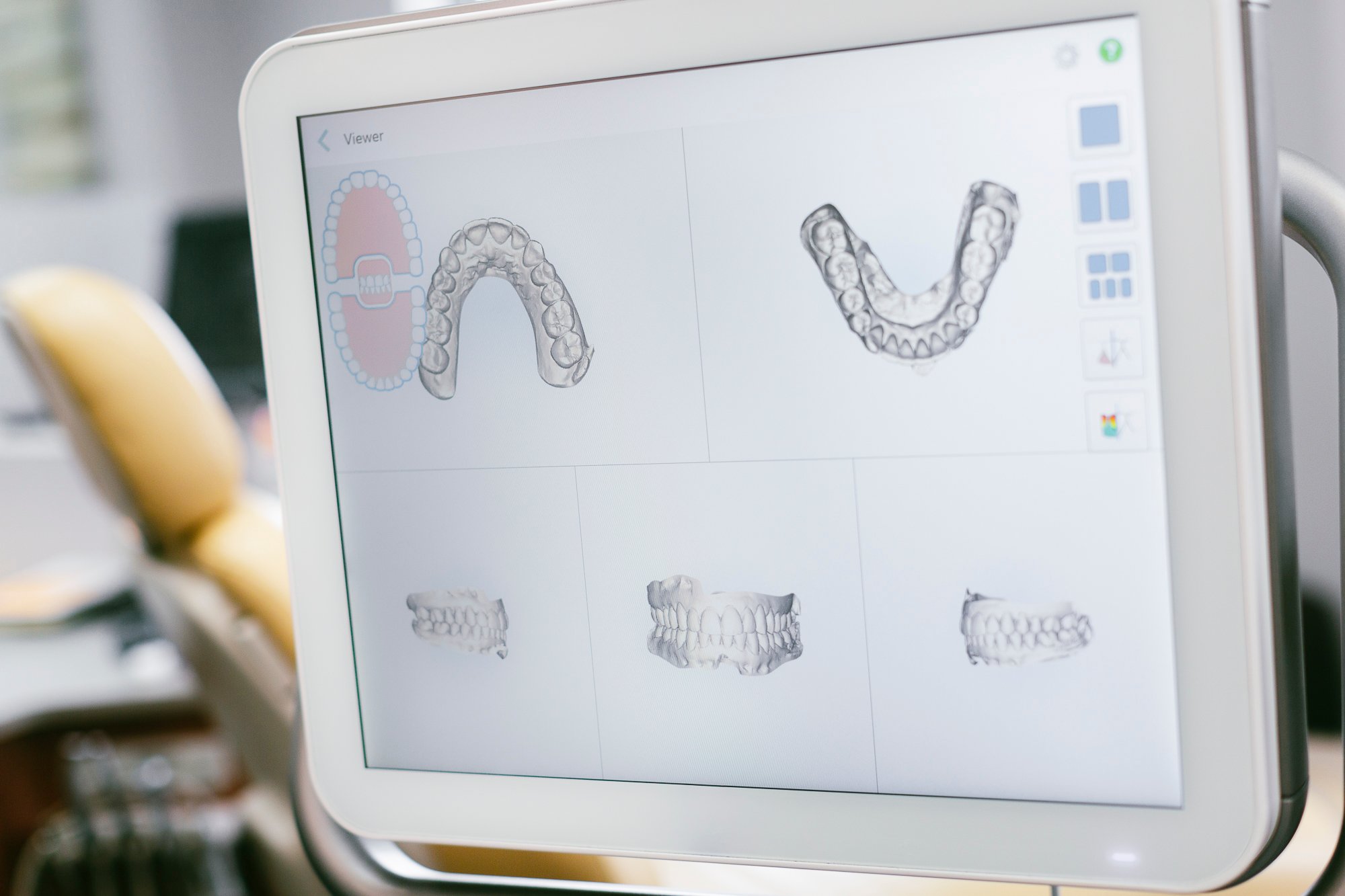How Braces Work to Straighten Your Teeth
In order to help you make the best decision as to which orthodontic treatment plan works best for you, we put together this extensive guide to understanding how braces work to straighten your teeth. Find out what your family can expect with this orthodontic treatment solution.
Traditional braces date back to the 18th century by French dentist Pierre Fauchard as a method of straightening teeth. Over the years, orthodontists have enhanced the experience of wearing braces to create a process that uses constant, gentle pressure that moves the teeth into their proper positions over time.
HOW DO BRACES WORK?
In order to shift your teeth into proper alignment with regular braces, several things must work in unison.
The Components
With traditional braces, we use several components and tools to straighten your teeth:
- A bracket is an individual ceramic or metal “brace” that affixes to each of your teeth with dental bonding glue.
- The archwire is a thin metal wire that threads through the brackets in order to apply gentle pressure and move your teeth into their ideal alignment.
- Elastic ties are also known as elastic rings, ligature elastics or donuts, and are used to hold the archwire to the brackets. The ties come in multiple colors, and you can switch up your colors each time you visit the orthodontist.
- Rubber bands are used in cases that require slightly more pressure to straighten and direct your teeth into proper alignment. The bands hook from brackets on the upper teeth to brackets on the lower teeth.
- Additional tools, such as tubes, hooks, loops, springs, steel ties, and bite correctors, are sometimes used in special cases. If these are necessary for your orthodontic treatment, our office will ensure you understand exactly what’s happening every step of the process.
The Process
Through a process called bone remodeling, braces apply constant, gentle pressure against your teeth to encourage your bones to begin adapting and ultimately holding your teeth in their new alignment for the rest of your life.
Bone remodeling works through the use of brackets and archwire, which align each tooth into its proper position. As your teeth ease into their new positions, we use thicker archwires and tighten your brackets in order to apply additional pressure and consistently move your teeth into the correct alignment.
Once we determine that your teeth have moved into the correct spot, we give you retainers to hold the teeth in place while the bone tissue around your teeth and jaws fully adapts to the new tooth positions. With proper retainer wear, your new and improved smile will last you a lifetime!
The Timeline
It typically takes 3-5 days for the bone remodeling process to start once your traditional braces are in place. There may be some soreness the first few days or even weeks as your teeth and jaw adjust to the new pressure inside your mouth. After the process gets started, it will take about three months to begin remodeling the bone, and it typically takes 1-3 years to fully stabilize the new bone and build your new smile.
ARE THERE DIFFERENT TYPES OF BRACES?
At Gorman & Bunch Orthodontics, you can choose from two types of braces for your teeth:
1. Traditional Metal Braces
These are the most traditional type of braces, which consist of metal brackets that are connected by a thin archwire. The combination of brackets and wire work together to push and pull your teeth into the right alignment. The archwire uses ligatures (or elastics, or o-rings) to connect to the brackets. The elastics come in all kinds of fun colors that you can swap out at each appointment.
2. Clear Braces
Otherwise known as transparent braces, clear braces are extremely similar to metal braces, except the brackets are created from a man-made sapphire material instead of metal. This transparent material is much less noticeable than metal braces.
ARE THERE FOODS YOU CANNOT EAT WITH BRACES?
To protect your braces, it’s important to know which foods you can eat and which foods to stay away from when wearing braces.
Foods to Avoid Eating With Braces
The first few days after getting braces, we strongly recommend only eating soft foods. All it takes is one damaging bite to hurt your teeth and extend the length of orthodontic treatment.
Hard food specifically can be damaging to your braces. Avoid biting into these foods with your front teeth, but rather cut them up into small pieces before eating:
- Raw vegetables
- Croutons
- French/Italian bread and pizza crust
- Meat on the bone
- Corn on the cob
- Apples
- Carrots
For the duration of your orthodontic treatment, avoid eating these foods all together:
- Crunchy foods like partially popped popcorn kernels, ice, pretzels, hard cookies, and chips.
- Sticky foods like caramels, gummies, sugary gum, and hard candy.
- Chewy foods like bagels and licorice.
- Hard foods like pizza crust, whole carrots, candy, nuts and taco shells.
Foods You Can Eat With Braces
Ready for the goods news? Here’s a list of great food options you can easily enjoy while wearing braces:
- Soft Fruits, like blueberries, grapefruits, nectarines, kiwi, bananas, grapes, and tangerines Steamed Vegetables (steamed for softness)
- Dairy Products, like yogurt and cheese
- Soft Grains and Noodles, like mac and cheese, cooked ravioli, quinoa, and rice
- Soft Meats, like tender chicken, turkey, meat loaf, lunch meat, and seafood
- Eggs, which are a good alternative to tough meats
- Desserts, like pudding, applesauce, smoothies, and ice cream
- Soft Breads, like tortillas, biscuits, muffins, pancakes
- Snacks, like soft crackers or cookies, peanut butter and jelly sandwiches, and hulless popcorn
Ready to schedule a free consultation?
WHAT’S IT LIKE TO WEAR BRACES?
Many parts of your day-to-day experience change once you wear braces, so it’s important to know what to expect.
LIFE WITH BRACES
We strongly recommend visiting an orthodontist at the age of seven. We may not start orthodontic treatment at this age, but want to watch your development to make sure no big issues occur. Because of this, we recommend that you schedule a follow-up appointment every six month to check-in on your teeth development. These appointments are free of charge and we will keep you updated on when future treatment will be needed.
Your very first appointment is complementary, and takes about an hour. Our friendly treatment coordinator will take digital scans of your teeth, and the orthodontist will perform an extensive exam. We will then go over any treatment plan that will be needed, including financial arrangements. If we feel you are ready to move forward with treatment (and you’re ready, too!), we can usually get started that day with braces or Invisalign.

LIVING WITH BRACES
Each person adapts to the discomforts of braces differently. There are a few minor braces side effects and we know they can be uncomfortable, and sometimes painful, which is why we put together our top five tips for living with braces:
Be Prepared Before Leaving Orthodontics Office
Right after getting your braces, check wire ends to make sure they aren’t sticking out and poking your cheeks or rubbing your tongue the wrong way. Also, talk to your orthodontist to understand what the next steps are, when your next appointment is, what additional rules you need to know and hygiene recommendations. Finally, double check to make sure you have all of the supplies you need, including dental wax, cleaning aids, elastic bands and more.
Be Aware of What You Eat With Braces
As mentioned above, there is a list of dos and don’ts when it comes to eating with braces. Stick to pasta, seedless bread, soft veggies, pudding, soup, yogurt, etc., for the first few days with braces. Then, start adding in more foods that you feel comfortable eating. Always stay away from sticky and hard foods that could damage your braces.
Use Wax to Relieve Soreness in Your Mouth
Brackets can sometimes rub on the inside of your mouth and cheeks, causing irritation and discomfort. If this happens, use dental wax to act as a buffer between your brackets and mouth.
Rinse Your Mouth Out With Saltwater Whenever Irritated
If you are experiencing discomfort on your cheeks and lips from your braces, a warm salt water rinse should help ease some of the pain. Add half a teaspoon of salt to one cup of warm water, and rinse for 30 seconds, 5 times per day.
Always Practice Good Oral Hygiene
We cannot stress enough how important it is to clean your teeth after every meal, floss, brush and make regular appointments with your dentist.
Visiting the Dentist
As we’ve mentioned above, we strongly recommend visiting your dentist for regular hygiene appointments and check-ups. We will work with your dentist throughout your orthodontic treatment to ensure your teeth and healthy during the process.
Chewing Gum With Braces
You may have heard that you should never chew gum with braces, but we believe a little differently. We suggest that while wearing braces, it is okay to chew sugarless gum in moderation, as long as you brush and floss around your wires and brackets after doing so.
Today’s braces consist of more durable brackets and wires, significantly reducing the potential damage from chewing gum. Additionally, chewing gum can actually help expel acids produced by the bacteria in plaque that leads to tooth decay. It can also strengthen your tooth enamel by delivering more calcium, phosphate, and fluoride to your mouth.
On the flip side, chewing gum with sugar stimulates that bacteria-causing acid in your mouth. Sugary gum can also stick to metal brackets and pull elastic ties off brackets, damaging your braces. And of course, too much sugary gum can cause cavities.
Orthodontic Emergencies
Although it’s very rare for an orthodontic emergency to happen, here’s how to handle various situations that may arise with your braces:
Loose or Broken Bracket
If you aren’t experiencing any pain or discomfort, leave the broken bracket in place and cover it with wax if it’s uncomfortable. If it comes off completely, give us a call to let us know, then bring it with you during your next visit. There is an added broken bracket cost at your next appointment if you do break them, so be very careful when wearing your braces.
Poking Wires
If your wires are sticking out and bothering your cheeks, use a pencil eraser, cotton swab, or ball of wax to try pushing back the wire back inside your molar tube. If this doesn’t work, try using nail clippers (disinfect first with rubbing alcohol) to cut the wire yourself.
Soreness, Pain, or Discomfort
If you’re experiencing any of these things, make sure you’re only eating soft foods and chewing sugarless gum. If the pain doesn’t go away after several days, give us a call and we’re happy to check it out.
Traumatic Events
If you experience a bad fall or something traumatic happens to your mouth that affects your braces, give us a call immediately. We will most likely need to do an x-ray to see if your teeth, gums or orthodontic appliances have been damaged.
HOW TO CARE FOR YOUR BRACES?
To keep your braces working properly — and streamline your treatment timeline — there are several good habits to form and bad habits to break while wearing braces.
Bad Habits with Braces
Most people know not to chew sugary gum while wearing braces, but there are several other bad habits to avoid while wearing braces in order to keep your teeth healthy:
Treating Your Teeth as a Tool
Don’t open a bag of chips with your teeth ever, especially while wearing braces. This will force your teeth to shift out of alignment or damage your brackets.
Chewing on Something Other Than Food
Don’t chew on anything besides food, such as straws, pencils, pens, and even ice! Doing so could cause your braces to chip, break or shift in ways we don’t want. Braces aren’t able to withstand constant pressure on them, so stick to chewing food only.
Biting Nails and Sucking Thumbs
It’s crucial that you don’t bite your nails or suck your thumb while wearing braces. Biting your nails is a terrible habit and can be very difficult to break, but doing them could bend your wires and break brackets. Sucking your thumb shifts your teeth even further out of alignment, damaging your teeth beneath braces.
Being Too Rough While Brushing Your Teeth
Your teeth will not become cleaner if you brush them harder. Instead, this can actually damage the tissue on your gums, resulting in pain, bleeding, soreness and even receding gums. It can also force brackets to come off.
Choosing Dark-Colored Beverages
Drinking dark drinks, such as coffee, red wine, black tea, and sodas will stain your teeth behind your brackets, leaving unwanted tooth coloring once you get your braces off. We strongly recommend using a straw while drinking these beverages, using mouthwash after drinking them, or better yet avoid them altogether.
Eating Too Much Sugar
You should also strive to avoid foods that are high in sugar, especially while wearing braces. Sugary foods leaves an acidic layer in your mouth that can eat away at your teeth. These foods are extremely harmful on your teeth, and make it much more difficult to properly clean around brackets.
Skipping Orthodontist or Dentist Appointments
There’s a reason why we recommend visiting your dentist every six months, and maintaining your agreed upon schedule with your orthodontist. Avoid big issues with your braces or major dental work by visiting your dentist and orthodontist regularly.
Good Habits with Braces
One of the most important habits to keep while wearing braces is flossing. Neglecting to floss with braces will increase your risk for dental cavities, gum disease and tooth decay. Additional issues you may experience include:
- Demineralization: Plaque build-up on your teeth, resulting in scarring and decay.
- Delay of Completion Time: Negative effects of not flossing could slow down your treatment schedule.
- Pain and Discomfort: Unhealthy teeth usually cause pain, aches and sensitivity as a result of cavities and decay.
- Stains: Bad oral hygiene may cause stained teeth around your braces.
Additionally, we strongly recommend visiting your dentist for regular hygiene appointments to ensure your teeth stay healthy and sparkling throughout orthodontic treatment.
WHY WEAR A RETAINER AFTER BRACES?
There’s nothing better than feeling your smooth teeth and looking at your straight smile for the first time! To keep them that way, we create a retainer for you to wear.
RETAINER TYPES
There are three different retainer types:
1. Hawley (aka Loop)
A thin, loop, tongue-shaped piece that is molded to fit your mouth. This uses wire to hold your teeth in position. It’s simple, durable and can be easily taken in and out of your mouth.
2. Clear (aka Hard Cast)
This retainer is similar to transparent braces or Invisalign. These are custom-made to fit your mouth using clear plastic. They are invisible and easy-to-remove.
3. Fixed (aka Permanent)
This is a popular choice for lower teeth, as it isn’t removable but also not visible. This retainer consists of a wire that is bonded to the backside of your lower canines and may remain in your mouth indefinitely.
Retainer Adjustments
Retainers are typically very easy to adjust to, and most patients report that they don’t even notice them after a few weeks. You may experience some difficulty talking at first, but that won’t last long. The most difficult part to remember is taking your retainers out when eating and brushing your teeth, and then putting them back in your mouth as soon as you’re done. Don’t be the person who accidentally throws away your retainer at lunch!
We recommend wearing your retainer 24/7 for the first ten weeks. Then we typically transition patients into only wearing retainers at night. If you start to notice a tightness when you put your retainer back in, that means you’ve gone too long without wearing it.
Retainer Care
We strongly recommend brushing your retainer each time you brush your teeth using cool water and a toothbrush. We’d also recommend soaking your retainer several times per week in retainer or denture cleaner. Mouthwash isn’t the best option because it can break down the plastic in your retainer.
Differences Between Braces vs. Invisalign
It’s important to understand the differences between braces and Invisalign so you can make the decision that’s best for your lifestyle:
BRACES
- Consist of metal or ceramic brackets on your teeth and an archwire that connects the brackets.
- Use constant, gentle pressure to move your teeth into the proper positions over time.
- Required to visit orthodontist every 6-8 weeks for follow-up visits to check on progress and adjust wires.
- Must avoid list of foods (outlined above).
INVISALIGN
- Consist of a series of clear, customized and removable aligners.
- Swap out aligners every week in order to gradually move teeth into alignment over time.
- Ability to remove aligners while eating, brushing, and flossing.
- Required to visit orthodontist every 12 weeks for check-up appointments.
In terms of orthodontic braces cost , braces and Invisalign cost the exact same amount of money. There is typically no difference in treatment time, unless a patient is noncompliant with wearing his or her Invisalign aligners the required 22 hours per day. This can prolong treatment with Invisalign and add to the cost of braces.
HOW DO BRACES AFFECT OVERALL HEALTH?
Beyond the aesthetic impact, straight teeth can impact your body’s health in several ways.
ORAL HEALTH
While braces are primarily used to simply straighten your teeth and give you a beautiful smile, they also have a positive impact on your overall oral health. Here’s how:
Overbite
An overbite occurs when your top teeth are too far ahead of your bottom teeth, which can result in clenching teeth that cause aching jaws and grinding teeth. With an overbite, your top teeth are also much more prone to trauma or injury. Using braces to fix an overbite will not only change the shape of your smile, but also the shape of your jaw structure for the better!
Underbite
Conversely, an underbite occurs when your bottom teeth protrude out farther than your top teeth. This often leads to aches and pains in your teeth and jaw, imbalanced facial appearance, and a hard time biting and chewing food. Fixing an underbite will also change the shape of your smile and jaw.
Crossbite
Crossbites occur when your teeth are misaligned. They cause wear and tear on your teeth and can lead to bone loss or gum disease. Braces will prevent these issues from happening and keep your mouth at its healthiest.
Crowded Teeth
This is the most common reason someone comes to us for orthodontic treatment. Crowded teeth are a result of lack of room in your mouth for your teeth to grow in properly. As a result, teeth become crooked and are difficult to clean, which creates a plaque buildup and can cause gum disease and bone loss. Fixing crowded teeth allows for easier flossing, brushing, and maintaining overall good oral health.
Because many of these issues begin at a very young age, we strongly recommend seeing an orthodontist at the age of seven.
HEART HEALTH
Not only does orthodontic treatment positively affect oral health, it can impact heart health as well.
Each of the issues we mentioned above — overbite, underbite, crossbite, overcrowding — make it difficult to brush and floss your teeth. That bacteria build-up of plaque and tartar can then lead to infections of the teeth, gums and potentially expand into the periodontal ligament and alveolar bone. These issues can result in a cardiovascular disease — called atherosclerosis — in which plaque build-up hardens inside your arteries. Atherosclerosis can also increase your risk of heart disease or stroke.
We know this can be daunting, which is why we so strongly encourage practicing good oral hygiene. By brushing your teeth after meals, flossing once a day, and visiting your orthodontist, you will be on the right path to greater oral and overall health.

Here at Gorman and Bunch Orthodontics, you’ll learn that we like straightening teeth. More importantly though, we like changing lives with beautiful smiles and improving the health and livelihood of our patients. If you’re curious about learning more about braces or other forms of orthodontic treatment, contact us today or schedule a complimentary initial consultation. We can’t wait to hear from you!
Want to See How Braces Work for You?
April 7, 2020
A diastema, or gap between teeth, is usually a natural part of a child’s development. For many children, the gap between their two front teeth closes with the…
January 15, 2020
The alignment of your teeth can drastically impact your health and overall comfort. If you or your child are consistently experiencing jaw pain, frequent…
December 17, 2019
Getting traditional braces is a rite of passage for many adults, teens, and children. It’s the start of their journey toward a beautiful, healthy smile! While…


